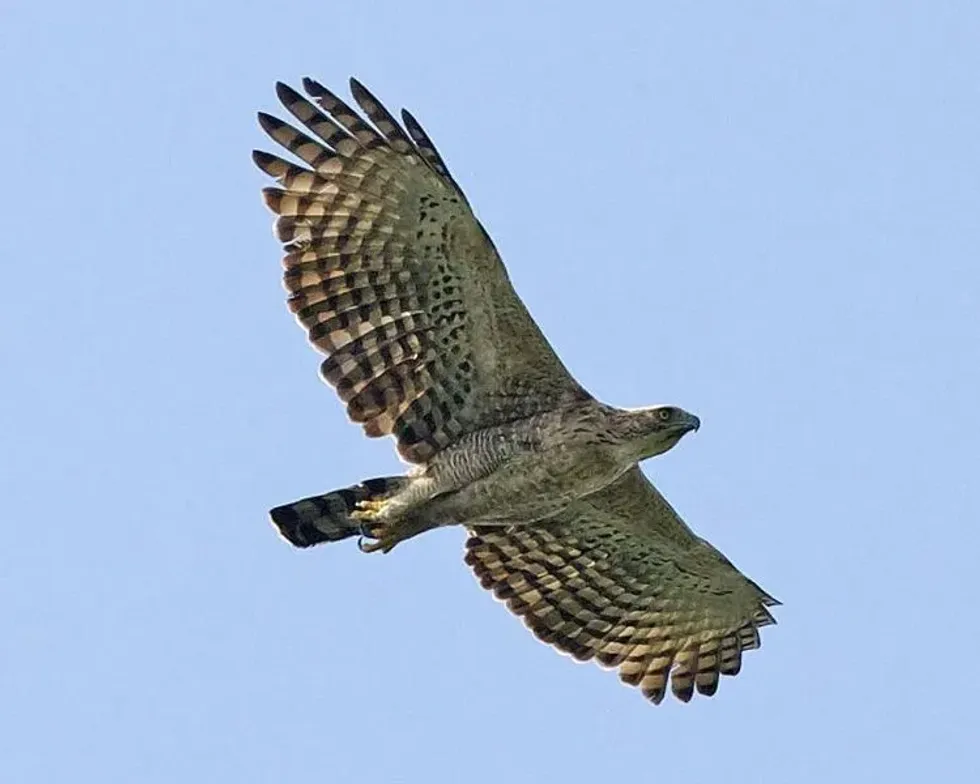The mountain hawk-eagle, Nisaetus nipalensis as it is scientifically known, is also known as Hodgson's hawk-eagle. It belongs to the Accipitridae family.
It is the largest in its genus out of 10 recognized species.
It is native to Asia and the range includes the Himalayas, eastern and southern parts of China, Japan, Russia, North Korea, India, and Sri Lanka. As the name suggests, the preferred habitat of this species is mountainous forests.
Mountain hawk eagles inhabit riparian, evergreen, and mixed deciduous forests. The reproduction system of these mountain hawk eagles is monogamous and the breeding season depends on the range.
The nest is built by using dead branches and built by both parents. The incubation is done by the female while the male brings the food.
These birds have brown or dark brown upperparts and are feather toed.
The tail of this bird is grayish-brown with a white tip. The tail of the young ones is banded and is shaded with light and dark brown and just like adults have a white tip.
The flying or flight feathers or wings of adults are gray-based with blackish-brown bars while in juveniles, the buff or tawny color is more prominent. The diet or food of this species includes small and medium-sized prey like snakes, lizards, pheasants, and squirrels.
There have been two subspecies of mountain hawk-eagles recognized. One subspecies is known as Nisaetus nipalensis orientalis, also known as Japanese hawk-eagle or Japanese mountain hawk-eagle, the Japanese hawk-eagles are known to have a short crest and the other subspecies is known as Nisaetus nipalensis nipalensis.
Another species of this genus Legge's hawk was once considered a subspecies of this bird but now it is a full species, Nisaetus kelaarti.
It is not a threatened species or population but is considered to be scarce in terms of population and is affected by deforestation and thus, habitat destruction. It is fascinating to know about the mountain hawk-eagle, Nisaetus nipalensis and if you are interested, read about these hawk facts and Kea parrot facts.
Mountain Hawk Eagle Interesting Facts
What type of animal is a mountain hawk eagle?
Mountain hawk-eagle, Nisaetus nipalensis as it scientifically known, are birds.
What class of animal does a mountain hawk eagle belong to?
It belongs to the class of Aves of birds.
How many mountain hawk eagles are there in the world?
There has been no specific number of these eagles recorded or estimated.
Where does a mountain hawk eagle live?
The range that the mountain hawk-eagle inhabits includes the Himalayas, eastern and southern parts of China, Japan, Russia, North Korea, India, and Sri Lanka.
What is a mountain hawk eagle's habitat?
The habitat of this bird includes hill, riparian, evergreen, and mixed deciduous forests. These birds can be spotted in wooded foothills. These birds are commonly spotted in mature forests and tend to prefer large trees for breeding. The preferred elevation range of these hawk eagles ranges from 3280.84-11482.94 ft (1000-3500 m) above sea level.
Who does mountain hawk eagle live with?
It is believed that these hawk eagles tend to live alone but can be spotted in groups occasionally.
How long does a mountain hawk eagle live?
The exact lifespan of this hawk-eagle is unknown.
How do they reproduce?
The reproduction system is known to be monogamous. The breeding season of these birds differs according to their range.
It takes place from December to March in Sri Lanka, around February and June in the Himalayas, and around January to April in Japan. The nest is built by both males and females using dead branches. The nest is placed on a long or large tree.
1-2 eggs are laid by the female and incubation is also done by the female for about 43-50 days while the male brings the food. Fledging happens after 70-80 days of hatching.
What is their conservation status?
The conservation status of this bird is Least Concern and is not considered a threatened species or population.
Mountain Hawk Eagle Fun Facts
What does mountain hawk eagle look like?
The adult bird has brown or dark brown upperparts and the edges are known to be lighter. The head is rusty colored and has black-colored streaks.
The crest is also black in color. The tail of this bird is grayish-brown with a white tip.
The tail of the young ones is banded and is shaded with light and dark brown and, just like adults, have a white tip. The throat is known to have large and sparsed or distributed black colored stripes. Juveniles are similarly colored but have cream-white feather edges and the leg feathers are also white in color.
It is a feather-toed eagle. The eyes of adults are orangish-yellowish in color while that of young ones or juveniles is light bluish or yellow in color.
The cere of the adult is blackish-gray in color while that of a young one is pale gray in color. The wings of adults are gray-based with blackish-brown bars while in juveniles, the buff or tawny color is more prominent in the wing pattern.

How cute are they?
These birds are not considered cute.
How do they communicate?
Not much information is available about the communication of these birds but just like other species, they also produce sounds and calls of varying kinds for various purposes. The call of this species is known to be very shrill and is mostly noisy during the breeding season.
How big is a mountain hawk eagle?
This species is known to be goose-sized and maybe sometimes larger and this species is very similarly sized to that of a golden eagle. The length of this hawk-eagle is estimated to be around 27-33 in (686-838 mm).
How fast can a mountain hawk eagle fly?
The exact flying speed of this species is unknown but they are known to fast ones.
How much does a mountain hawk eagle weigh?
The weight of Hodgson's hawk-eagle is estimated to be around 4-7.7 lb (1.8-3.5 kg).
What are the male and female names of the species?
There are no specific names for a male and female of the mountain hawk eagles.
What would you call a baby mountain hawk eagle?
There is no particular name for a baby of this bird and it is generally referred to as young one or juveniles.
What do they eat?
This bird is known to feed or prey on small or medium-sized mammals, reptiles, and other birds. It has been observed that this bird prefers to prey on hares in mammals and other mammals include squirrels, shrew moles, and others include ducks, poultry, junglefowl, and pheasant. The reptile prey includes lizards and snakes.
Are they poisonous?
This species is not considered poisonous.
Would they make a good pet?
Not much information is available about this species as pets but it is believed that these hawks are wild and do not make good pets.
Did you know...
This bird was initially categorized under the genus Spizaetus.
This species is known to be the second-largest Asian hawk eagles and the largest member in the genus Nisaetus, out of the 10 presently recognized populations.
There have been two subspecies of the mountain hawk eagles recognized, namely, Nisaetus nipalensis orientalis, also known as Japanese hawk-eagle or Japanese mountain hawk-eagle, and is found in Japan, parts of China, and Korea. This subspecies is known to have a short crest.
The other subspecies is Nisaetus nipalensis nipalensis, found in range of Pakistan, Himalayas, Bhutan, Nepal, China.
Another species, Legge's hawk-eagle is considered a subspecies of this bird by some authorities, while some consider them as a full species, Nisaetus kelaarti as there are certain differences in DNA sequences, vocalizations, morphology, and plumage.
The plumage of this bird is known to be very similar to that of a crested-hawk eagle, changeable hawk-eagle, Nisaetus cirrhatus, and the Aigle Montagnard. Aigle Montagnard is a known relative of these hawk-eagles.
Both males and females are known to produce calls, especially the breeding pair. It has been observed that this species is silent generally and is noisy around and during the breeding period or season and is quite noticeable in their range.
What is a hawk-eagle?
Hawk-eagles are small and light-bodied or built eagles. These have legs that are fully feathered and have large or long beaks or bills and feet.
There are certain differences between a hawk and an eagle; eagles are large birds with large wingspan while hawks are small with short wingspan. Eagles are one of the most powerful birds while hawks, as compared are less powerful.
Are they predators?
Yes, mountain hawk eagles are known to be an opportunistic predator as it hunts or preys on mammals, birds, and reptiles.
Here at Kidadl, we have carefully created lots of interesting family-friendly animal facts for everyone to discover! For more relatable content, check out these magpie facts and Cooper's hawk facts.
You can even occupy yourself at home by coloring in one of our free printable mountain hawk-eagle coloring pages.









